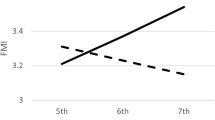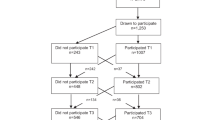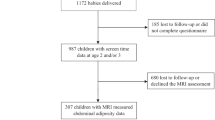Abstract
OBJECTIVE: To prospectively examine the relation between television watching and body fat change in children from preschool to early adolescence.
METHODS: In a longitudinal study, 106 children were enrolled during preschool years (mean age 4.0?y) and followed into early adolescence (mean age 11.1?y). Parents completed an annual questionnaire on the child's television and video habits. Body mass index (BMI), triceps skinfolds, and sum of five skinfolds were recorded yearly at annual clinic visits. Longitudinal statistical analyses were carried out using mixed modeling procedures to control for potential confounding by a number of factors.
RESULTS: Television watching was an independent predictor of the change in the child's BMI, triceps, and sum of five skinfolds throughout childhood. Its effect was only slightly attenuated by controlling for the baseline body fat, level of physical activity (as measured repeatedly by Caltrac accelerometer), percent of calories from fat, total calorie intake, or the parents' BMI or education. By age 11, children who watched 3.0?h or more of television per day had a mean sum of skinfolds of 106.2?mm, compared with a mean sum of skinfolds of 76.5?mm for those who watched less than 1.75?h per day (P=0.007). Furthermore, the adverse effect of television viewing was worse for those children who were also sedentary or had a higher-fat diet.
CONCLUSIONS: Children who watched the most television during childhood had the greatest increase in body fat over time. Healthy lifestyle education designed to prevent obesity and its consequences should target television-watching habits of children.
This is a preview of subscription content, access via your institution
Access options
Subscribe to this journal
Receive 12 print issues and online access
$259.00 per year
only $21.58 per issue
Buy this article
- Purchase on Springer Link
- Instant access to full article PDF
Prices may be subject to local taxes which are calculated during checkout





Similar content being viewed by others
References
Berenson GS, Srinivasan SR, Hunter SM, Nicklas TA, Freedman DS, Shear CL, Webber LS . Risk factors in early life as predictors of adult heart disease: the Bogalusa Heart Study. Am J Med Sci 1989; 298: 141–151.
Kelder SH, Perry CL, Klepp KI, Lytle LL . Longitudinal tracking of adolescent smoking, physical activity, and food choice behaviors. Am J Public Health 1994: 84; 1121–1126.
Lauer RM, Lee J, Clarke WR . Factors affecting the relationship between childhood and adult cholesterol levels: the Muscatine Study. Pediatrics 1988; 82: 309–318.
Serdula MK, Ivery D, Coates RJ, Freedman DS, Williamson DF, Byers T . Do obese children become obese adults? A review of the literature. Prev Med 1993; 22: 167–177.
Hu FB, Leitzmann MF, Stampfer MJ, Colditz GF, Willett WC, Rimm EB . Physical activity and television watching in relation to risk for type 2 diabetes mellitus in men. Arch Intern Med 2001; 161: 1542–1548.
Kuczmarski RJ, Flegal KM, Campbell SM, Johnson CL . Increasing prevalence of overweight among US adults. The National Health and Nutrition Examination Surveys, 1960 to 1991. JAMA 1994; 272: 205–211.
Troiano RP, Flegal KM, Kuczmarski RJ, Campbell SM, Johnson CL . Overweight prevalence and trends for children and adolescents: the National Health and Nutrition Examination Surveys, 1963 to 1991. Arch Pediatr Adolesc Med 1995; 149: 1085–1091.
Dietz WH, Gortmaker SL . Do we fatten our children at the television set? Obesity and television viewing in children and adolescents. Pediatrics 1985; 75: 807–812.
Wong ND, Hei TK, Qaqundah PY, Davidson DM, Bassin SL, Gold KV . Television viewing and pediatric hypercholesterolemia. Pediatrics 1992; 90: 75–79.
Jeffery RW, French SA . Epidemic obesity in the United States: are fast foods and television viewing contributing? Am J Public Health 1998; 88: 277–280.
Hernandez B, Gortmaker SL, Colditz GA, Peterson KE, Laird NM, Parra-Cabrera S . Association of obesity with physical activity, television programs and other forms of video viewing among children in Mexico City. Int J Obes Relat Metab Disord 1999; 23: 845–854.
Robinson TN, Hammer LD, Killen JD, Kraemer HC, Wilson DM, Hayward C, Taylor CB . Does television viewing increase obesity and reduce physical activity? Cross-sectional and longitudinal analyses among adolescent girls. Pediatrics 1993; 91: 273–280.
DuRant RH, Baranoski T, Johnson M, Thompson WO . The relationship among television watching, physical activity and body composition of young children. Pediatrics 1994; 94: 449–455.
Moore LL, Nguyen UDT, Rothman KJ, Cupples LA, Ellison RC . Preschool physical activity level and change in body fatness in young children: The Framingham Children's Study. Am J Epidemiol 1995; 142: 982–988.
Noland M, Danner F, Dewalt K, McFadden M, Kotchen JM . The measurement of physical activity in young children. Res Q Exerc Sport 1990; 61: 146–153.
Schakel SF, Sievert YA, Buzzard IM . Sources of data for developing and maintaining a nutrient data base. J Am Diet Assoc 1988; 88: 1268–1271.
Marmot MG, Adelstein AM, Robinson N, Rose G . Changing social class distribution of heart disease. Br Med J 1978; 2: 1109–1112.
Klesges RC, Shelton ML, Klesges LM . Effects of television on metabolic rate: potential implications for childhood obesity. Pediatrics 1993; 91: 281–286.
Taras HL, Sallis JF, Patterson TL, Nader PR, Nelson JA . Television's influence on children's diet and physical activity. Dev Behav Pediatr 1989; 10; 176–180.
Borzekowski DLG, Robinson TN . Effect of commercials on preschoolers. Nutr Res Newslett 2001; 20: 1–2.
Robinson TN . Can a school-based intervention to reduce television use decrease adiposity in children grades 3 and 4? Evidence-based Nurs 2000; 3: 43.
Epstein LH, Paluch RA, Gordy CC, Dorn J . Decreasing sedentary behaviors in treating pediatric obesity. Arch Pediatr Adolesc Med 2000; 154: 220–226.
Robinson TN . Reducing children's television viewing to prevent obesity. JAMA 1999; 282: 1561–1567.
Luepker RV, Perry CL, McKinlay SM, Nader PR, Parcel GS, Stone EJ, Webber LS, Elder JP, Feldman HA, Johnson CC . Outcomes of a field trial to improve children's dietary patterns and physical activity. The Child and Adolescent Trial for Cardiovascular Health (CATCH). JAMA 1996; 275: 768–776.
Acknowledgements
This study is supported by Grant no. HL35653 from The National Heart, Lung and Blood Institute.
Author information
Authors and Affiliations
Corresponding author
Rights and permissions
About this article
Cite this article
Proctor, M., Moore, L., Gao, D. et al. Television viewing and change in body fat from preschool to early adolescence: The Framingham Children's Study. Int J Obes 27, 827–833 (2003). https://doi.org/10.1038/sj.ijo.0802294
Received:
Revised:
Accepted:
Published:
Issue Date:
DOI: https://doi.org/10.1038/sj.ijo.0802294
Keywords
This article is cited by
-
Improving nutrition and physical activity environments of family child care homes: the rationale, design and study protocol of the ‘Healthy Start/Comienzos Sanos’ cluster randomized trial
BMC Public Health (2019)
-
Insufficient Physical Activity and Overweight: Does Caregiver Screen-Viewing Matter?
Journal of Child and Family Studies (2019)
-
Sex-specific longitudinal associations of screen viewing time in children at 2–3 years with adiposity at 3–5 years
International Journal of Obesity (2019)
-
Systematic review of the relationships between sedentary behaviour and health indicators in the early years (0–4 years)
BMC Public Health (2017)
-
The effect of a cluster randomised control trial on objectively measured sedentary time and parental reports of time spent in sedentary activities in Belgian preschoolers: the ToyBox-study
International Journal of Behavioral Nutrition and Physical Activity (2016)



